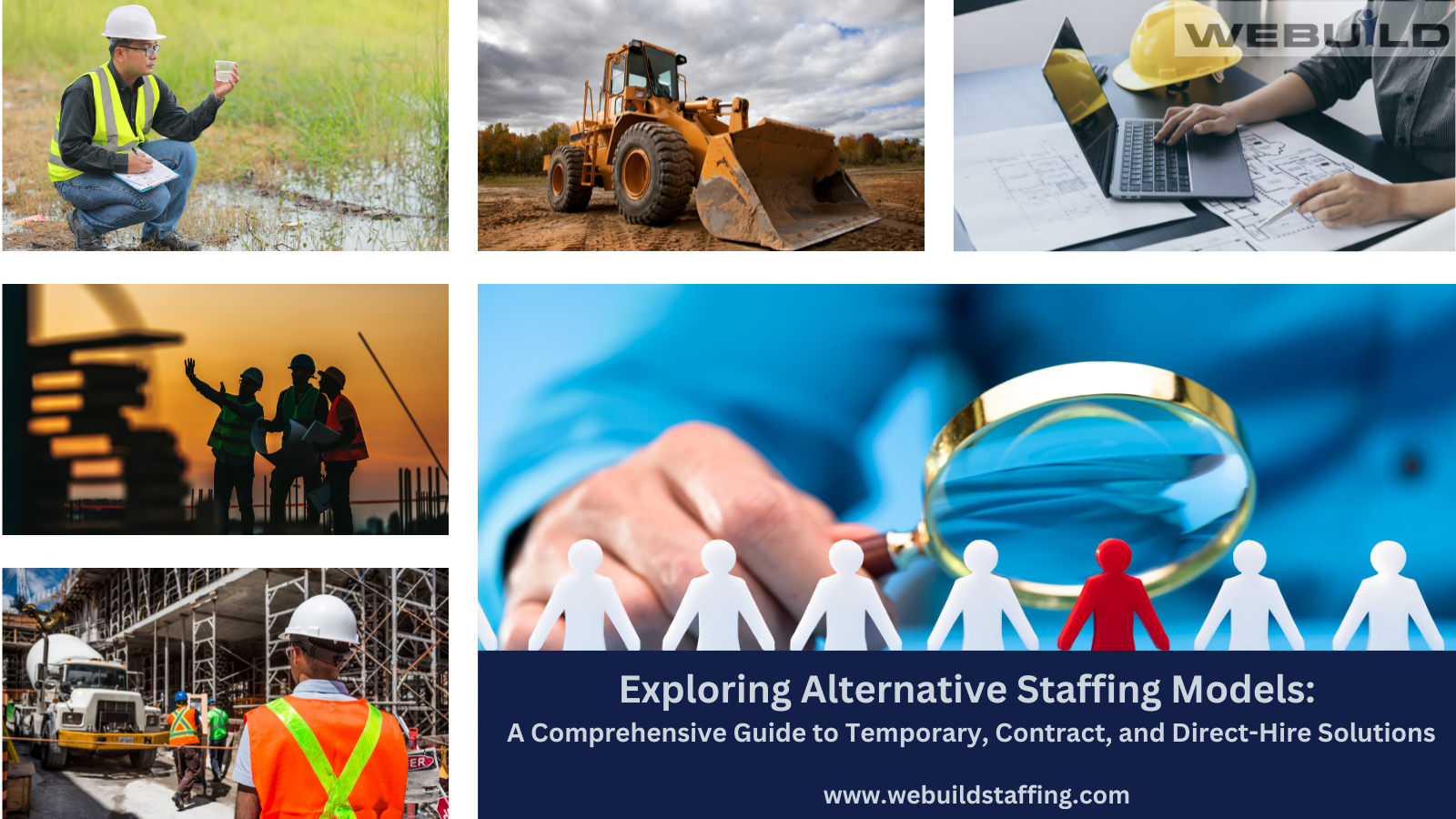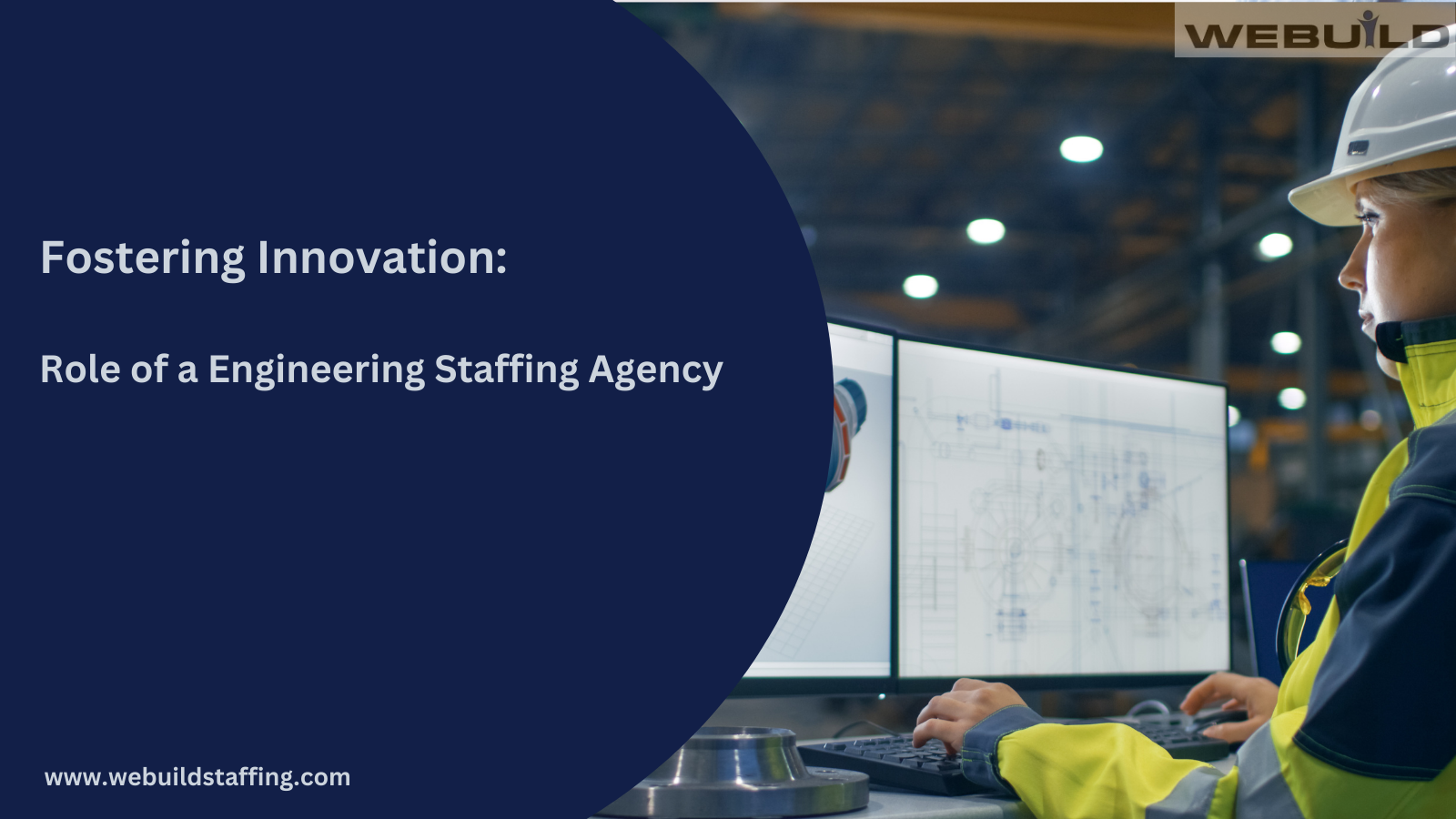Alternative Staffing Models: Temporary, Contract, and Direct-Hire Options
WEBUILD STAFFING BLOG |
Alternative Staffing Models: Temporary, Contract, and Direct-Hire Options

Employers are increasingly turning to alternative staffing models to meet their workforce needs while maximizing flexibility, efficiency, and cost-effectiveness. Temporary, contract, and direct-hire staffing options offer distinct advantages and considerations for both employers and job seekers. These alternative staffing models offer many benefits and challenges for navigating the diverse landscape of contingent workforce solutions.
Understanding Alternative Staffing Models:
- Temporary Staffing:
Temporary staffing involves hiring workers on a short-term basis to fulfill specific roles or projects. Temporary employees, also known as temps or contingent workers, are typically employed by staffing agencies and assigned to client companies on a contract basis. Temporary staffing provides employers with flexibility to scale their workforce up or down based on fluctuating demand, seasonal trends, or project-based needs, while offering workers opportunities for temporary employment, skills development, and exposure to different industries and roles.
- Contract Staffing:
Contract staffing involves hiring workers on a fixed-term basis to perform specific tasks, projects, or assignments. Contract employees, also known as independent contractors or freelancers, work directly for client companies under contractual agreements, often providing specialized skills or expertise for short-term projects or engagements. Contract staffing offers employers flexibility to access specialized talent on-demand, reduce overhead costs, and mitigate risks associated with long-term employment commitments, while providing contractors with autonomy, flexibility, and potential for higher earnings.
- Direct-Hire Staffing:
Direct-hire staffing, also known as permanent placement or full-time staffing, involves hiring workers for permanent positions within client companies. Direct-hire employees are typically recruited and hired by staffing agencies on behalf of client companies, with the intention of establishing long-term employment relationships. Direct-hire staffing offers employers access to a wider talent pool, reduced time-to-fill, and enhanced retention rates, while providing job seekers with stability, benefits, and career advancement opportunities within client organizations.
Benefits and Considerations of Alternative Staffing Models:
- Flexibility:
Temporary and contract staffing models offer employers greater flexibility to adjust their workforce size and composition in response to changing business needs, market conditions, and project requirements. Employers can scale their workforce up or down quickly, without the long-term commitments and administrative burdens associated with traditional hiring processes.
- Cost-Effectiveness:
Alternative staffing models can be more cost-effective for employers compared to traditional hiring methods, particularly for short-term or project-based needs. By outsourcing recruitment, onboarding, and payroll administration to staffing agencies, employers can reduce overhead costs, minimize compliance risks, and optimize resource allocation, resulting in significant cost savings over time.
- Access to Specialized Talent:
Contract staffing enables employers to access specialized talent and expertise for specific projects or initiatives that require niche skills or industry knowledge. By leveraging the expertise of contract professionals, employers can accelerate project timelines, enhance innovation, and achieve better business outcomes without the need for extensive training or investment in permanent hires.
- Retention and Engagement:
Direct-hire staffing models offer employers the opportunity to build long-term relationships with employees, fostering loyalty, engagement, and commitment to the organization’s mission and values. By investing in employee development, career advancement, and benefits packages, employers can attract top talent, reduce turnover, and create a more stable and productive workforce over time.
- Compliance and Risk Management:
Staffing agencies play a crucial role in ensuring compliance with labor laws, regulations, and industry standards across alternative staffing models. By partnering with reputable staffing agencies, employers can mitigate risks associated with misclassification, wage and hour violations, and worker mismanagement, ensuring legal and ethical practices throughout the employment lifecycle.
Challenges and Mitigation Strategies for Alternative Staffing Models:
- Quality of Talent:
One challenge associated with alternative staffing models is ensuring the quality and suitability of talent recruited by staffing agencies. To mitigate this risk, employers should establish clear selection criteria, communicate expectations and requirements upfront, and collaborate closely with staffing agencies to source, screen, and onboard qualified candidates who align with their organizational culture and values.
- Retention and Engagement:
Retention can be a challenge in temporary and contract staffing arrangements, as workers may be more likely to seek permanent employment opportunities or pursue other options after completing assignments. To address this challenge, employers should focus on building strong employer brands, offering competitive compensation and benefits, and providing opportunities for skills development, career growth, and advancement within the organization.
- Legal and Compliance Risks:
Compliance with labor laws, regulations, and industry standards is essential for employers utilizing alternative staffing models. To mitigate legal and compliance risks, employers should partner with reputable staffing agencies that adhere to best practices and industry standards, conduct regular audits and assessments of staffing processes and practices, and stay informed about relevant legal developments and regulatory changes affecting contingent workforce management.
- Communication and Collaboration:
Effective communication and collaboration between employers and staffing agencies are critical for the success of alternative staffing models. Employers should establish clear expectations, roles, and responsibilities for all parties involved, maintain open lines of communication, and provide feedback and performance evaluations to ensure alignment and accountability throughout the employment lifecycle.
- Cultural Fit and Integration:
Cultural fit and integration can be challenging in temporary and contract staffing arrangements, as workers may have limited exposure to client organizations’ cultures, values, and norms. To foster cultural fit and integration, employers should provide orientation and onboarding support, facilitate introductions and networking opportunities, and encourage open dialogue and feedback between temporary workers and permanent employees.
Best Practices for Implementing Alternative Staffing Models:
- Define Clear Objectives and Requirements:
Before engaging with staffing agencies, employers should clearly define their staffing needs, objectives, and requirements for temporary, contract, or direct-hire positions. Consider factors such as project scope, timeline, budget, and skill requirements to ensure alignment with business goals and objectives.
- Select Reliable Staffing Partners:
Choose reputable staffing agencies with a proven track record of success, industry expertise, and a commitment to quality and compliance. Research staffing agencies’ reputations, credentials, and client testimonials, and conduct interviews or site visits to assess their capabilities, processes, and service offerings before making a decision.
- Establish Clear Contracts and Agreements:
Negotiate clear and comprehensive contracts and agreements with staffing agencies to outline roles, responsibilities, expectations, and deliverables for all parties involved. Include provisions for performance metrics, service level agreements (SLAs), confidentiality, intellectual property rights, and dispute resolution mechanisms to ensure clarity and accountability.
- Communicate and Collaborate Effectively:
Maintain open lines of communication and collaboration between employers, staffing agencies, and temporary workers throughout the employment lifecycle. Provide regular updates, feedback, and performance evaluations to ensure alignment with business objectives, address issues or concerns promptly, and foster a positive and productive working relationship.
- Monitor and Evaluate Performance:
Monitor and evaluate the performance of alternative staffing arrangements regularly to assess their effectiveness, efficiency, and impact on business outcomes. Track key performance indicators (KPIs) such as time-to-fill, turnover rates, quality of hires, and client satisfaction to identify areas for improvement and inform decision-making and resource allocation.
Real-World Examples of Alternative Staffing Models:
Several organizations have successfully implemented alternative staffing models to meet their workforce needs and achieve strategic objectives:
Billings Construction Company:
Billings Construction Company utilizes a combination of temporary, contract, and direct-hire staffing models to support its project-based needs and strategic initiatives. The company partners with staffing agencies to source and recruit temporary workers for seasonal projects, contract professionals for specialized assignments, and direct-hire employees for permanent positions within the organization. By leveraging alternative staffing models, Billings Construction Company can scale its workforce up or down quickly, access specialized talent on-demand, and maintain flexibility and agility in response to changing market conditions.
Conner Engineering:
Conner Engineering Firm adopts a direct-hire staffing model to build and grow its in-house team of engineering professionals. The company partners with staffing agencies to identify and recruit top talent for permanent positions within the organization, focusing on skills, experience, and cultural fit. By investing in direct-hire staffing, Conner Engineering Firm can attract and retain high-performing employees, foster a cohesive and collaborative work environment, and drive innovation and excellence in its projects and services.
Alternative staffing models offer employers a range of options for meeting their workforce needs while maximizing flexibility, efficiency, and cost-effectiveness. By understanding the benefits and considerations of alternative staffing models, implementing best practices for their implementation, and learning from real-world examples of success, employers can optimize their contingent workforce strategies and achieve better business outcomes in today’s dynamic and competitive labor market.
Webuild Staffing Agency is a leading executive search and staffing agency dedicated to the construction, engineering and environmental industries. To learn more please visit: www.webuildstaffing.com










